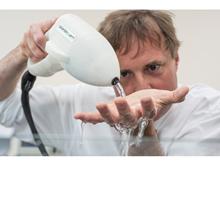Sonic weapons evidence far from sound following ‘attacks’ in Cuba and China

Southampton Professor Tim Leighton has raised serious doubts of sound being used to harm embassy staff in Cuba and China in recent months where diplomatic personnel claimed they’d suffered health problems after being exposed to some sort of ‘sonic weapon’.
Professor Leighton, an experienced researcher in Ultrasonics and Underwater Acoustics, has investigated many claims of ultrasonic exposure before but is yet to encounter evidence of a genuine ultrasonic attack. He is, however, aware of people suffering nausea and other symptoms after accidental exposures caused by emissions from pet scarers and other devices including door openers and public address systems.
His takeaway message is that debate on the situations in Cuba and China would be greatly enhanced if two words - brain and attack - were removed from the debate until proof supporting them is given.
In a blog written at the invitation of the Asia & The Pacific Policy Society, Professor Leighton insists that there are steps which must be taken to rule out non-acoustic causes, or accidental acoustic exposures, before claims of attack by an ultrasonic weapon are taken seriously.
“If someone comes to me with complaints of an ultrasonic attack, there is a process of elimination to go through,” Professor Leighton explains. “I first check for more likely causes: poisoning, illness, and sometimes the confusion of tinnitus with ultrasound. If these are ruled out, and ultrasound is present in the suspect location, I look for the source, because one cannot begin to discuss ‘attacks’ until accidental exposure has been eliminated.
“It is vital that the true source of symptoms is identified, because if it is not ultrasonic, then the sufferer cannot be helped if they persist in misidentifying the cause of the problem,” he continues. “From the limited evidence available, the working hypothesis is that if one can hear the ultrasound, one is far more likely to suffer ill effects. In addition, the ability to hear high frequencies varies hugely between individuals. If a group of people are exposed, the effect on any individual will be unpredictable, with adult men usually the least susceptible.
“This last point would make ultrasound a curious choice of weapon to attack diplomats, because adult men are perhaps the most robust people against attack: children are more likely to suffer,” Professor Leighton concludes. “Furthermore, it is not a long-range weapon: ultrasound does not travel far in air. With a commercial ultrasonic ‘pest scarer’ placed in a room, only the individuals in that room, and perhaps the neighbouring room, are exposed to levels sufficient to cause adverse effects – and only in a minority of individuals.”
Professor Leighton also explains that ‘sonic’ acoustic waves (waves at a frequency people can hear) can lead to a range of adverse reactions, depending on the quality and intensity of the sound, and the attitude of the person hearing it.
“Birdsong might be pleasant in a garden, but if that same acoustic energy were present in a persistent whine or as the sound of nails scratching on a blackboard, it could generate adverse effects, particularly if the sufferer believes that the sound is being maliciously projected at them from a neighbour,” says Professor Leighton. “Such adverse effects from audible attacks range from those arising from annoyance, anxiety and stress (for example headaches or inability to concentrate) to, at louder levels, a temporary or permanent hearing impairment. Such sonic exposures are not covert.
“The additional fear when an ultrasonic exposure is suggested is that it is covert: the sufferer cannot hear the exposure and does not know when they are being exposed, and so cannot respond to exposure by moving away,” he concludes.
In addition to criticising premature use of the word ‘attack’, Professor Leighton also criticises references to brain injury that have been made. “The tests undertaken in the US were too easy to fail by individuals in a normal, healthy group of people. Therefore to take political steps against another nation based on having selected people from Cuba fail those tests is rash. For over half a year we have been hearing of claims of brain injury resulting from an ultrasonic attack, and when at last we get sight of the evidence on which those claims are based, we find that evidence currently to be insufficient to support those claims”.
Professor Leighton’s blog Hearing things? A process of elimination casts doubt on reports of ‘sonic attacks’ in Cuba and China is published on the Asia & The Pacific Policy Society website.
